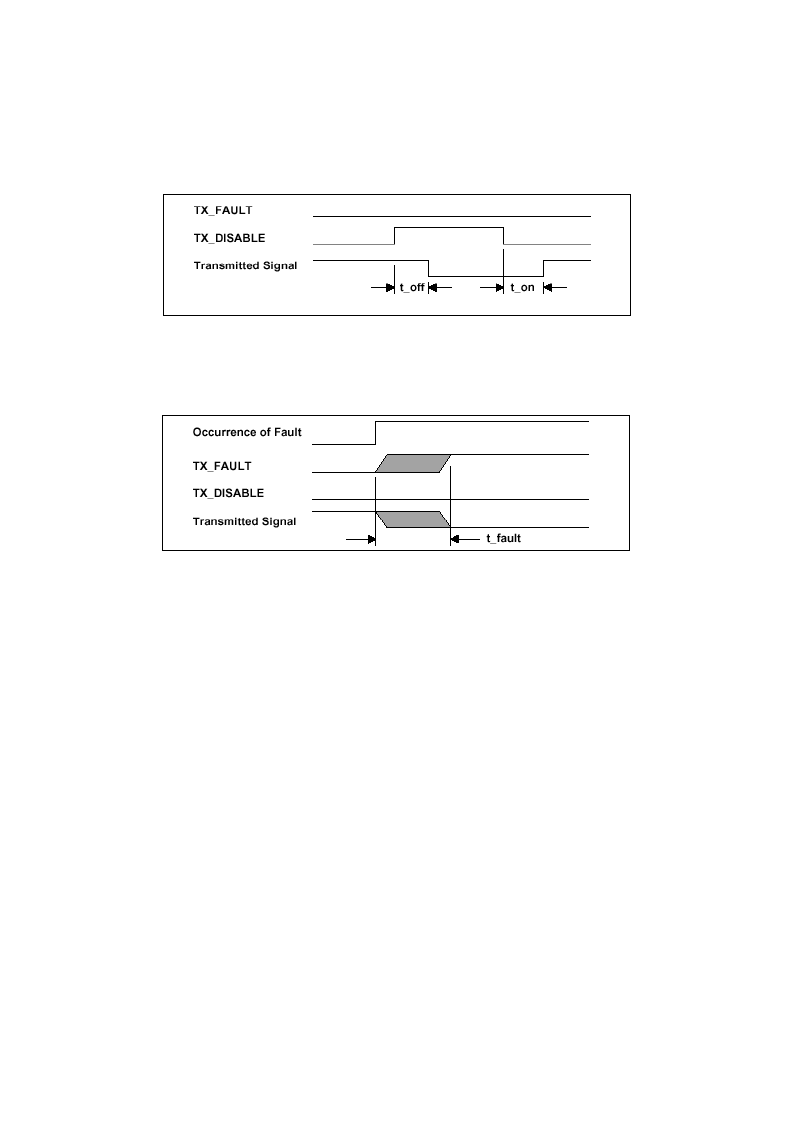- 您現在的位置:買賣IC網 > PDF目錄382685 > TR117FA-0D30S Optoelectronic PDF資料下載
參數資料
| 型號: | TR117FA-0D30S |
| 英文描述: | Optoelectronic |
| 中文描述: | 光電 |
| 文件頁數: | 10/14頁 |
| 文件大小: | 207K |
| 代理商: | TR117FA-0D30S |

10
transceiver using the TX_DISABLE signal are shown in Figure 6. Note that the t_on
time refers to the maximum delay until the modulated optical signal reaches 90% of
the final value, not just the average optical power.
Figure 6. SFP Tx Disable timing during normal operation
SFP transceiver fault detection and presentation
Figure 7. Detection of transmitter safety fault condition
SFP transceiver fault recovery
The detection of a safety-related transmitter fault condition presented by TX_FAULT
shall be latched. The following protocol may be used to reset the latch in case the
transmitter fault condition is transient. To reset the fault condition and associated
detection circuitry, TX_DISABLE shall be asserted for a minimum of t_reset.
TX_DISABLE shall then be negated. In less than the maximum value of t_init the
optical transmitter will correctly reinitialize the laser circuits, negate TX_FAULT, and
begin normal operation if the fault condition is no longer present. If a fault condition is
detected during the reinitialization, TX_FAULT shall again be asserted, the fault
condition again latched, and the optical transmitter circuitry will again be disabled
until the next time a reset protocol is attempted. The manufacturer of the SFP shall
ensure that the optical power emitted from an open connector or fiber is compliant
with IEC825-1 and CDRH during all reset attempts, during normal operation or upon
the occurrence of reasonable single fault conditions. The SFP transceiver may
require internal protective circuitry to prevent the frequent assertion of the
TX_DISABLE signal from generating frequent pulses of energy that violate the safety
requirements. The timing for successful recovery from a transient safety fault
condition is shown in Figure 8.
相關PDF資料 |
PDF描述 |
|---|---|
| TR117FA-0D40S | Optoelectronic |
| TR133LA-0A10S | Telecomm/Datacomm |
| TR133LA-0D30S | Optoelectronic |
| TR137FA-0D30S | Optoelectronic |
| TR25202 | 64-Bit Graphics (GUI) Accelerator |
相關代理商/技術參數 |
參數描述 |
|---|---|
| TR117FA-0D40S | 制造商:未知廠家 制造商全稱:未知廠家 功能描述:Optoelectronic |
| TR118 | 制造商:未知廠家 制造商全稱:未知廠家 功能描述:TIMER COUNTDOWN TWIN CHANNEL |
| TR11-A1-S | 制造商:MITSUMI 制造商全稱:Mitsumi Electronics, Corp. 功能描述:Transformers for Inverter or Converter |
| TR11-A-S | 制造商:Mitsumi USA & Europe 功能描述:ELECTRONIC COMPONENT |
| TR-11BX630.5A | 功能描述:斷路器 0.5A/240V, INTEGRAL MOUNTING RoHS:否 制造商:Phoenix Contact 產品:Device Circuit Breakers 產品類型:Thermomagnetic 電流額定值:2 A 電壓額定值 AC:240 V, 277 V 電壓額定值 DC:50 V 極數:1 Pole 執行器類型:Slide 電路功能:Trip Free 系列:CB TM1 工作溫度范圍:- 30 C to + 60 C 照明:No |
發布緊急采購,3分鐘左右您將得到回復。